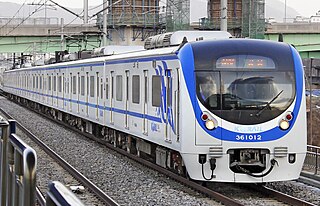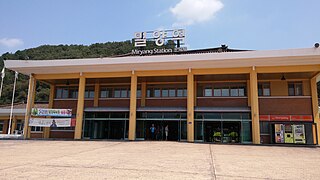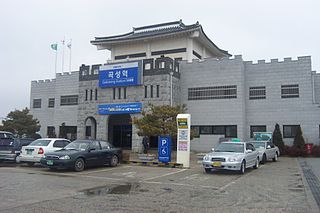
The Korea Railroad Corporation is the national railway operator in South Korea. It is branded as KORAIL (코레일) and changed its official Korean name in November 2019. Currently, KORAIL is a public corporation, managed by Ministry of Land, Infrastructure and Transportation.

The Gyeongchun Line is a regional rail line between Seoul and Chuncheon, South Korea, operated by Korail. Its name is derived from Gyeong and Chuncheon. It was completely reconstructed in the 2000s. Service on it has operated between Sangbong station on the Jungang Line in eastern Seoul and Chuncheon station, as part of the Seoul Metropolitan Subway system, since December 21, 2010. A class of regional rail service named ITX-Cheongchun began operations on February 28, 2012, linking Chuncheon to Cheongnyangni and Yongsan Stations.

The Gyeongui Line is a railway line between Seoul Station and Dorasan Station in Paju. Korail operates the Seoul Metropolitan Subway service between Seoul Station and Dorasan Station.

The Gyeongjeon Line (Gyeongjeonseon) is a railway line serving South Gyeongsang and South Jeolla Provinces in South Korea. It covers a total of 300.6 km, from Samnangjin Station in Miryang, South Gyeongsang, to Gwangju Songjeong Station in Gwangju, South Jeolla.

Seoul Subway Line 4 of the Seoul Metropolitan Subway is a long line crossing from the southwest to the northeast across the Seoul National Capital Area. The central section in Seoul City is operated by Seoul Metro with some trains offering through service to Korail's Ansan and Gwacheon Lines. The southern terminus (Oido) is in Jeongwang 4-dong, Siheung City, and the northern terminus (Jinjeop) is in Jinjeop-eup, Namyangju-si, Gyeonggi-do; the newly built northern section is correspondingly owned by a company owned by Namyangju-si, with operations contracted to Seoul Metro. In 2022, the Seoul Metro operated section had an annual ridership of 219,587,000 or about 601,608 passengers per day.

Cheongnyangni Station (Korean: 청량리역) is a major railway station located at Dongdaemun-gu, Seoul, South Korea. It serves as a terminus for passenger trains serving the eastern part of South Korea. KTX, ITX-Cheongchun, and Mugunghwa-ho trains terminates or stops at this station. Several Seoul Metropolitan Subway lines serve the station. These are: Seoul Subway Line 1, the Gyeongchun Line, the Suin–Bundang Line and the Gyeongui–Jungang Line.

Dorasan Station (Korean: 도라산역) is a railway station situated on the Gyeongui–Jungang Line, which formerly connected North Korean and South Korean rail systems and has since been restored. Dorasan station is located approximately 650 meters from the southern boundary of the Korean Demilitarized Zone and is currently the northern terminus of Korail's Gyeongui-Jungang Line, which is served by Shuttle Service to Imjingang Station. North of here the former Gyeongui Line continues as the Korean State Railway's P'yŏngbu Line, but this connection is not in regular service. The current purpose of the station is largely symbolic of the hope for eventual Korean reunification.

Gupo station is a Korail station on the Gyeongbu Line, between Hwamyeong station and Sasang station, located in northern Busan, South Korea. It was opened on 1 January 1905, and is connected with the subway Gupo station on Busan Metro Line 3 via an overhead bridge, so passengers can transfer.

Gwangmyeong station (Korean: 광명역) is a train station in Gwangmyeong, South Korea. The station was newly built as a stop of national railway operator Korail's KTX high-speed service, 22.0 km (13.7 mi) south of Seoul Station.

Miryang station is on the normal speed Gyeongbu Line, 55 km south of Dongdaegu Station. Miryang station is an important branch of the Gyeongbu and Gyeongjeon lines. The surrounding area is filled with numerous tourist attractions such as Ice Valley, Pyochungsa Temple, Pyochungbi, Jaejak Mountain and Unmun Mountain, as well as famous mountains called Yeongnam Alps. Especially in summer, there is a theater festival held in Miryang Theater Village and a cool ice valley without long clothes. It is a station that is the center of economy and tourism.

GwangjuSongjeong Station is a station in Gwangju, South Korea. It is on the national high-speed KTX railway network, 341 km south of Yongsan Station.

Kwangwoon University station is a train station on Seoul Subway Line 1, Gyeongchun Line and Gyeongwon Line in Seoul, South Korea operated by Korail. Together with Incheon station and Suwon station, this station was one of the three termini of Line 1 when it opened in 1974. Seongbuk Depot, one of the five depots of Line 1, is located nearby.

Ilsan Line is a subway line operated by Korail, in Seoul, South Korea. Trains from this line continue to and from Seoul Metro's Line 3.

The Gyeonggang Line (경강선) is a rail line in South Korea, which at present comprises two distinct sections. The first one, which opened on September 24, 2016, is part of the Seoul Metropolitan Subway system in Gyeonggi Province, South Korea, and runs from the city of Seongnam to Yeoju City, partially coinciding with the route of the former narrow-gauge Suryeo Line. The second section, which is located entirely in Gangwon Province, runs between Gangneung and Wonju and opened on December 22, 2017, in anticipation of the 2018 Winter Olympics. This section of the line offers KTX service from Seoul, through the Jungang Line. In the future, the two sections are to be connected, and the Gyeonggang Line will be extended westwards to Siheung.

The KTX-I, also known as the TGV-K or Korail Class 100000, is a South Korean high speed train class based on the French TGV Réseau. The 20-car formation of the trainsets without restaurant car is optimized for high capacity. The 46 trainsets were built partly in France and partly in South Korea in the framework of a technology transfer agreement, which was the basis for further domestic high-speed train development in South Korea.
High-speed rail service in South Korea began with the construction of a high-speed line from Seoul to Busan in 1992, and was inspired by Japan's Shinkansen. The first commercial high-speed rail service was launched on 1 April 2004. Currently, South Korea hosts two high-speed rail operators: Korea Train eXpress (KTX) and Super Rapid Train (SRT).

G-Train aka West Gold Train (Korean: 서해금빛열차) is a South Korean tourist train operated by Korail. The train began operations in 2015 and transports tourists from Seoul along the coastal areas of the West Sea.

Jeongdongjin station (Korean: 정동진역) is a railway station on the Yeongdong Line of Korail, the station closest to the beach in South Korea, and a popular cross country train destination from Seoul, for sunrise viewing. It is claimed to be listed in the Guinness World Records as being the closest station and tracks to a beach anywhere in the world.

Seoul Transportation Corporation, branded as Seoul Metro (Korean: 서울교통공사), is a municipal-owned corporation owned by Seoul Metropolitan Government, and one of the two major operators of Seoul Metropolitan Subway with Korail.

Gokseong station is a KTX station in the county of Gokseong, South Jeolla Province, on the southern coast of South Korea. It is on the Jeolla Line.



















